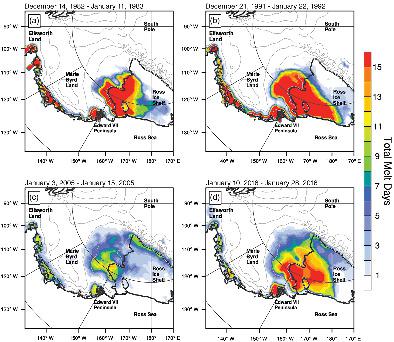当前位置:
X-MOL 学术
›
Q. J. R. Meteorol. Soc.
›
论文详情
Our official English website, www.x-mol.net, welcomes your
feedback! (Note: you will need to create a separate account there.)
Major surface melting over the Ross Ice Shelf part I: Foehn effect
Quarterly Journal of the Royal Meteorological Society ( IF 3.0 ) Pub Date : 2021-05-18 , DOI: 10.1002/qj.4104 Xun Zou 1, 2 , David H. Bromwich 1, 2 , Alvaro Montenegro 2 , Sheng‐Hung Wang 1 , Lesheng Bai 1
Quarterly Journal of the Royal Meteorological Society ( IF 3.0 ) Pub Date : 2021-05-18 , DOI: 10.1002/qj.4104 Xun Zou 1, 2 , David H. Bromwich 1, 2 , Alvaro Montenegro 2 , Sheng‐Hung Wang 1 , Lesheng Bai 1
Affiliation

|
West Antarctica (WA), especially the Ross Ice Shelf (RIS), has experienced more frequent surface melting during the austral summer recently. The future is likely to see enhanced surface melting that will jeopardize the stability of ice shelves and cause ice loss. We investigate four major melt cases over the RIS via Polar Weather Research and Forecasting (WRF) simulations (4 km resolution) driven by European Centre for Medium-Range Weather Forecasts (ECMWF) Reanalysis 5th Generation (ERA5) reanalysis data and Moderate Resolution Imaging Spectroradiometer (MODIS) observed albedo. Direct warm air advection, recurring foehn effect, and cloud/upper warm air introduced radiative warming are the three major regional causes of surface melting over WA. In this paper, Part I, the first two factors are identified and quantified. The second paper, Part II, discusses the impact of clouds and summarizes all three factors from a surface energy balance perspective. With a high-pressure ridge located westward towards the Sulzberger Ice Shelf (77° S, 148° W) and a low-pressure center located between 165° and 180° W, warm marine air from the Ross Sea is advected towards the coastal RIS and leads to surface melting. When the high-pressure ridge is located farther east towards Marie Byrd Land (120–150° W), the foehn effect can cause a 2–4°C increase in surface temperature on the leeside of the mountains. For three of four melt cases, more than 40% of the melting period experiences foehn warming. Isentropic drawdown is usually the dominant foehn mechanism and contributes up to a 14°C temperature increase, especially when strong low-level blocking occurs on the upwind side. The thermodynamic mechanism can be important depending on the strength of moisture uptake and condensation on the windward side. Meanwhile, sensible heat flux contributes less to foehn warming, but still plays an important role in the melting. The prediction of future stability of the RIS should include foehn warming as a major driver.
中文翻译:

罗斯冰架上的主要表面融化第一部分:焚风效应
西南极洲 (WA),尤其是罗斯冰架 (RIS),最近在南方夏季经历了更频繁的地表融化。未来可能会看到地表融化加剧,这将危及冰架的稳定性并导致冰块流失。我们通过由欧洲中期天气预报中心 (ECMWF) 再分析第 5 代 (ERA5) 再分析数据和中分辨率成像光谱仪驱动的极地天气研究和预报 (WRF) 模拟(4 公里分辨率)调查了 RIS 上的四种主要融化情况(MODIS) 观察到反照率。直接暖空气平流、反复出现的焚风效应和云/高层暖空气引入辐射变暖是西澳地表融化的三个主要区域原因。在本文的第一部分中,前两个因素被确定和量化。第二篇论文,第二部分,讨论了云的影响,并从表面能量平衡的角度总结了所有三个因素。高压脊向西朝向苏尔茨贝格冰架(77° S,148° W),低压中心位于 165° 和 180° W 之间,来自罗斯海的温暖海洋空气平流向沿海 RIS并导致表面熔化。当高压脊位于更靠东的玛丽伯德地 (120–150° W) 时,焚风效应会导致山脉背风侧的表面温度升高 2–4°C。在四个融化案例中的三个案例中,超过 40% 的融化周期经历了焚风变暖。等熵下降通常是主要的焚风机制,并导致温度升高 14°C,特别是当逆风侧发生强烈的低层阻塞时。热力学机制可能很重要,这取决于迎风侧的水分吸收和冷凝强度。同时,显热通量对焚风升温的贡献较小,但在融化中仍起着重要作用。RIS 未来稳定性的预测应包括焚风变暖作为主要驱动因素。
更新日期:2021-05-18
中文翻译:

罗斯冰架上的主要表面融化第一部分:焚风效应
西南极洲 (WA),尤其是罗斯冰架 (RIS),最近在南方夏季经历了更频繁的地表融化。未来可能会看到地表融化加剧,这将危及冰架的稳定性并导致冰块流失。我们通过由欧洲中期天气预报中心 (ECMWF) 再分析第 5 代 (ERA5) 再分析数据和中分辨率成像光谱仪驱动的极地天气研究和预报 (WRF) 模拟(4 公里分辨率)调查了 RIS 上的四种主要融化情况(MODIS) 观察到反照率。直接暖空气平流、反复出现的焚风效应和云/高层暖空气引入辐射变暖是西澳地表融化的三个主要区域原因。在本文的第一部分中,前两个因素被确定和量化。第二篇论文,第二部分,讨论了云的影响,并从表面能量平衡的角度总结了所有三个因素。高压脊向西朝向苏尔茨贝格冰架(77° S,148° W),低压中心位于 165° 和 180° W 之间,来自罗斯海的温暖海洋空气平流向沿海 RIS并导致表面熔化。当高压脊位于更靠东的玛丽伯德地 (120–150° W) 时,焚风效应会导致山脉背风侧的表面温度升高 2–4°C。在四个融化案例中的三个案例中,超过 40% 的融化周期经历了焚风变暖。等熵下降通常是主要的焚风机制,并导致温度升高 14°C,特别是当逆风侧发生强烈的低层阻塞时。热力学机制可能很重要,这取决于迎风侧的水分吸收和冷凝强度。同时,显热通量对焚风升温的贡献较小,但在融化中仍起着重要作用。RIS 未来稳定性的预测应包括焚风变暖作为主要驱动因素。











































 京公网安备 11010802027423号
京公网安备 11010802027423号